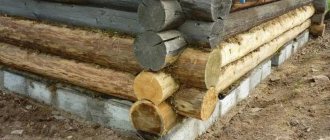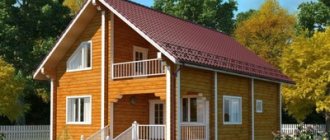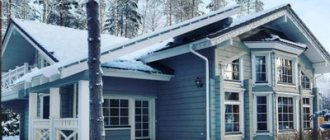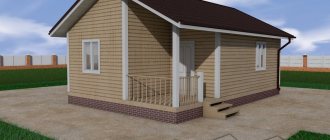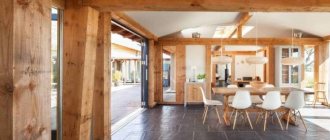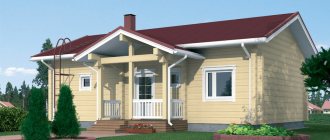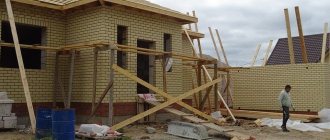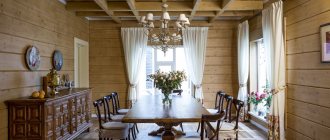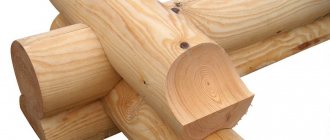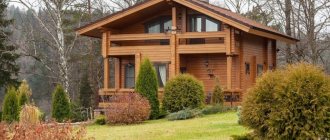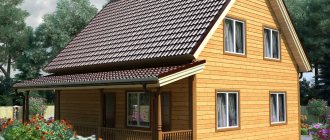Treatment of a wooden house after construction is an essential part of its operation. Without protection, the tree quickly darkens, deteriorates, rots, and insects appear inside. As a result, the appearance deteriorates and the service life is reduced. Proper treatment protects the walls from the sun, moisture and pests, and becomes an additional decoration of the cottage.
When processing a wooden house made of timber after construction, it is important to protect the surface, but preserve the natural properties of the materials. From the article you will learn when, how and with what to treat a wooden cottage so that it becomes beautiful, receives reliable protection and does not lose the pleasant aroma of a coniferous forest.
Tasks for painting walls from the inside:
- The coating protects the wall from dirt and abrasions. The sanded surface is easy to stain - the dirt eats into the wood, and sometimes you have to remove a layer of wood to remove it. It is much easier to wash off dirt from a painted wall.
- Paint is needed to protect against high humidity and direct ingress of water. If it is decided to leave exposed wood in the “wet zone,” then the walls are painted with a waterproof compound or covered with a moisture-resistant impregnation. This technology is used in bathrooms, swimming pools, and kitchen work areas.
- The right shade helps solve design problems. The color of the walls is chosen taking into account the purpose of the rooms: calm shades for bedrooms, neutral shades for common areas, bright shades for the kitchen and living room. It is important not to overdo it with saturation, otherwise the walls can visually reduce the volume of the room.
Bedroom in a house according to the SV-4 project
Purposes of processing and painting walls outside:
- The coating prevents exposure to ultraviolet radiation. Direct sunlight discolors and dries out the outer part of the fibers, accelerating the destruction of wood. Unpainted areas quickly darken and become brittle.
- The paint coating film protects the walls from direct moisture. The paint does not absorb water - drops flow down the surface, the wood retains normal humidity. Without coating, the fibers swell, lose their shape, and cracks appear on the timber.
- The antiseptic protects the tree from insect pests, fungus, and mold. The wall is impregnated with an antiseptic before painting or multifunctional paints and varnishes are used.
- Paint affects the appearance of a building. When painting a wooden house, natural wood shades are often preserved, but there are houses made of timber in white, pink, blue and even black.
House according to project SP-4
Why are the ends sealed?
A special sealant is applied to the ends of the beam, which completely blocks the ingress of water through the end cut, without interfering with natural moisture and air exchange. Without sealant, moisture quickly absorbs and evaporates through the cross section, the wood swells, cracks, and collapses. It is easier for pests to penetrate the tree through the end. The most correct option is to tightly seal the ends.
Technologies for processing a wooden house made of timber after construction
Antiseptic . Necessary to prevent the formation of fungus, mold, and insect damage. For antiseptic use, special impregnations are used that penetrate the wood and destroy pests.
It is especially important to use an antiseptic if the construction is carried out from ordinary timber or logs - beetles and microorganisms often grow in heartwood. Logs are often completely immersed in antiseptic baths directly on the construction site and further treated after construction.
Glued laminated timber is not so susceptible to rotting - the manufacturing technology includes several mandatory stages of testing and chamber drying. Glued laminated timber is treated with an antiseptic on the outside - this is enough.
Painting . This is the final stage of processing a wooden wall - the composition with colorant is applied to the wood in 2-3 layers, creating protection from ultraviolet radiation and moisture. When painting, the wood texture is preserved (glaze coating) or completely hidden (covering).
The paint is applied in 2 or 3 layers with preliminary and intermediate sanding. Painting technology depends on the manufacturer's recommendations.
Complex processing . To speed up and reduce the cost of processing, universal compositions are used: paint that contains an antiseptic. This approach speeds up construction and makes processing cheaper.
How to properly store lumber
Even before applying an antiseptic to the logs, you should know how to properly store lumber. They are stored in the form of a log house or timber quite simply.
Proper storage of lumber reduces the likelihood of mold and mildew
They need to be folded through spacers to ensure high-quality air circulation over the entire surface. This will ensure normal evaporation of moisture inside the lining, so damp lining will rarely be seen.
But even if you choose the most optimal option for storing rounded wooden material, it may show obvious signs of deterioration. To save the future rafter system for the house, you should start taking action.
What is the plan of salvation? The first step is to clean not the inside of the log house, but the outside, since at first the fungus does not penetrate inside. The affected layer is removed with rough sandpaper or a scraper, after which an antiseptic can be applied.
When the fungus has gone deep into a wooden log, you should use a stronger agent, such as a solution of Snowball or whiteness, but you should choose the latter impregnation option only when the appearance of bright spots on the surface of the log house is not critical. That is, for installing a floor, roof or for a rafter system, this can be a problem, since the stains will be noticeable. The affected area of a rounded beam can also be cut out - using a jointer it is possible to reduce the size of a solid board.
Basic stages of processing a wooden house after construction
- Checking humidity. For high-quality painting, the wall humidity should be within 12-15%.
- Primary grinding. Wood is sanded not only for leveling - mechanical processing opens the pores and ensures deep penetration of the antiseptic.
- Antiseptic. Pre-impregnation with an antiseptic is necessary when using regular wood paint. If the composition contains an antiseptic, the item is skipped.
- Padding. The primer penetrates the fibers and ensures a strong bond between the paint and varnish coating and the wall. When priming an external wall made of laminated veneer lumber, a thin layer of paint is usually used, which already contains an antiseptic.
- Intermediate sanding. Soft mechanical processing removes possible irregularities - when priming, the “pile” on the fibers rises.
- Application of intermediate and final coating. Three-layer painting creates the most saturated color and reliably protects the wood from precipitation, sun, and pests.
- End sealing. The sealant is applied according to the manufacturer's recommendations.
The most effective options for applying antiseptics
As in other similar work, the working surfaces of a log house, log, lining or rounded beam must be prepared before protecting them from the negative effects of moisture.
Nothing can be applied to a damp surface; accordingly, it must be dried. Otherwise, the rafter system made of this wood may crack both inside and outside, which will jeopardize the integrity of the entire structure. Dirt and dust must also be removed.
It is advisable to choose weather that is no more than 30 degrees; it will also be better if there is no precipitation that day, and it does not matter what kind of material should be prepared for the roof or floor. Next, the composition is prepared for use, and how exactly this is done is indicated by manufacturers on their products. Usually, the instructions are detailed and clearly explain what needs to be done.
The surface of a log house or rounded beam will be much better protected if the composition is applied in several successive layers. This means that it would be wiser to wait until the previous layer has completely dried, and then only proceed to apply a new one. Any method of applying the solution involves treating the entire surface of the wood in order to avoid creating a natural condition for the appearance of fungus both inside and outside.
If the floor surface will be treated with varnish, then this should be done immediately after applying the solution - then exposure to moisture in the future will not be so dangerous.
How to treat a wooden house after construction
To prevent protection from spoiling the feeling of a new wooden house, you need to choose a neutral composition of paints and varnishes. GOOD WOOD uses SEDIPAN products, a water-based acrylic paint. The coating applies smoothly, dries quickly, and leaves no odor.
For exterior painting, we use the WACT 640 line as a primer - the products contain a large amount of antiseptic and colorant, which additionally protects the wall from ultraviolet radiation. For interior decoration, it is enough to use WACT 650 - a paint with a lower antiseptic content. We seal the ends with a special compound WV 024, which completely blocks the sap-conducting channels, without disrupting the moisture and air exchange of the wood.
Which antiseptic to choose?
The range of these products in stores is very wide. Experts advise giving preference to Swedish or Finnish brands. There are also combined preparations that, in addition to antiseptic properties, have fire-fighting options.
It is very important to choose a composition that is safe for humans and does not emit odor. Therefore, it is better to give preference to well-known brands that have proven themselves positively over a long time.
offers to purchase edged boards or timber. Don’t forget to treat the materials with an antiseptic before starting construction!
Processing results
- Long-lasting barrier against pests, insects, fungus. The sealant protects the end, the antiseptic impregnates the outer part, and the paint prevents the protection from being washed away.
- Ultraviolet light does not cause wood to darken. The house retains its “fresh” color. If the color is chosen correctly, then there is no resin release or burnout on the surface.
- Moisture protection. The film covers the entire wall, even after a serious rainfall the walls do not get wet.
- The house corresponds to the design project. The cottage is beautiful inside and out.
Why does wood start to rot?
First of all, we are talking about improper storage of the material - this leads to the so-called blue discoloration beginning to appear on the surface of the wood.
Usually, after cutting, the boards are stacked outside, rarely when they are stored indoors. If the process occurs at sub-zero temperatures, then the beams will accumulate moisture from precipitation, and when they are folded tightly together, then there is no point in talking about ventilation.
The natural process of rotting begins in warm weather, when accumulated moisture begins to evaporate, creating the already mentioned blue spots.
Wood defects
For a log house or timber, fungus is a serious danger in the sense that it spreads very quickly; accordingly, if measures are not taken in time, then it will not be possible to create a rafter system inside a house or a wooden floor from the material, since the type of lumber, as well as its properties, will be lost.
When to treat a wooden house
It is recommended not to delay with protective coatings and to paint the house in the first 3-6 months after construction. Before painting, be sure to check the humidity of the walls - manufacturers of paints and varnishes usually indicate 12-15% in the instructions.
Question to a specialist: - Is it possible to paint a house in winter? — Most paints and varnishes are applied at a temperature not lower than 15 °C. If you need to paint a house in winter, we build greenhouses and heat it with heat guns. If the technology is followed, the paint will not dry for long.
Mold and insects. The influence of low temperatures on their activity
With the arrival of winter, when the temperature reaches zero, insects fall into suspended animation. Insects do not always die in the cold, and in most cases they easily endure the winter, and become more active when the temperature rises above zero. The peak activity and reproduction of insects occurs at temperatures from +10°C to +35°C.
Mold also stops developing at sub-zero temperatures and activates at positive temperatures, calmly surviving freezing.
The air temperature in different regions of the country fluctuates throughout the winter from minus to plus. This means that insect and mold activity in some cases continues throughout the year.
It is worth considering the unpredictability of the weather, since in winter precipitation may fall in the form of rain or sleet, which can sharply increase air humidity. The risk of damage to wood in such cases reaches 100%. All this leads to additional costs in the spring associated with sanding wood and treating with antiseptics.
Of course, wood is subject to restoration and subsequent use, but if basic rules of protection are constantly neglected, its service life is reduced.
Having answered the question about the need to use an antiseptic, let's look directly at the compositions themselves.
Where to order treatment at home
It doesn’t matter who paints the cottage - a construction company or a third-party team. The main thing is that painters know how to work with wood. GOOD WOOD has its own painting department, where you can order professional finishing of a laminated timber home. All work is controlled by a technical supervision engineer.
Checking the thickness of the paint coating is an important point in the painting phase. Want to know more about painting? Call GOOD WOOD and schedule an appointment with a painting representative. If necessary, a specialist visits the site, assesses the condition of the walls, helps you choose the color and treatment option.
